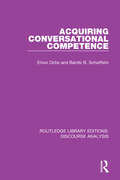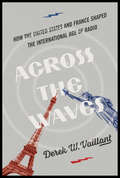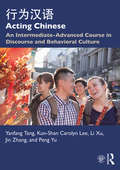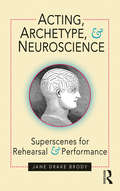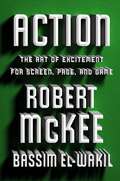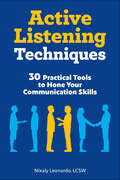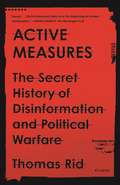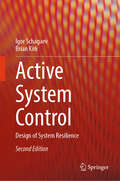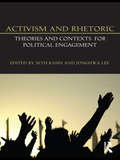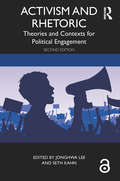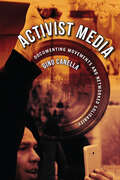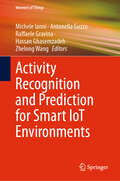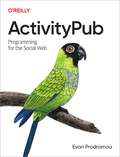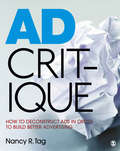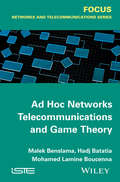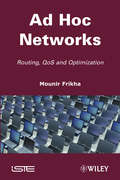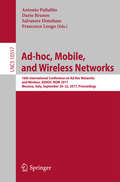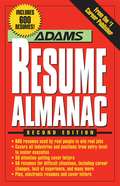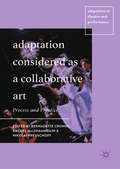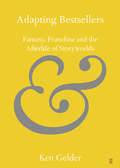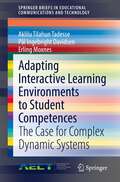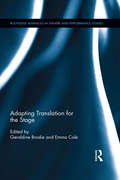- Table View
- List View
Acquiring conversational competence (RLE: Discourse Analysis)
by Elinor Ochs Bambi B. SchieffelinFirst published in 1983, this book represents a substantial body of detailed research on children’s language and communication, and more generally on the nature of interactive spoken discourse. It looks at areas of competence often examined in young children’s speech have that have not been described for adults — leading to insights not only in the character of adult conversation but also the process of acquiring this competence. The authors set forward strategies for conversing at different stage of life, while also relating these strategies to, and formulating hypotheses concerning, the dynamics of language variation and change.
Across the Waves: How the United States and France Shaped the International Age of Radio
by Derek W VaillantIn 1931, the United States and France embarked on a broadcasting partnership built around radio. Over time, the transatlantic sonic alliance came to personify and to shape American-French relations in an era of increased global media production and distribution. Drawing on a broad range of American and French archives, Derek Vaillant joins textual and aural materials with original data analytics and maps to illuminate U.S.-French broadcasting's political and cultural development. Vaillant focuses on the period from 1931 until France dismantled its state media system in 1974. His analysis examines mobile actors, circulating programs, and shifting governmental and other institutions shaping international radio's use in times of war and peace. He explores the extraordinary achievements, the miscommunications and failures, and the limits of cooperation between America and France as they shaped a new media environment. Throughout, Vaillant explains how radio's power as an instantaneous mass communications tool produced, legitimized, and circulated various notions of states, cultures, ideologies, and peoples as superior or inferior.
Acting Chinese: An Intermediate-Advanced Course in Discourse and Behavioral Culture 行为汉语
by Jin Zhang Li Xu Peng Yu Yanfang Tang Kunshan Carolyn LeeActing Chinese is a year-long course that, together with the companion website, integrates language learning with the acquisition of cultural knowledge, and treats culture as an integral part of human behavior and communication. Using modern day examples of Chinese discourse and behavioral culture, it trains students to perform in culturally appropriate fashion, whilst developing a systematic awareness and knowledge about Chinese philosophy, values and belief systems that will prepare them for further advanced study of Chinese language and culture. Each lesson contains simulated real-life communication scenarios that aim to provide a concrete opportunity to see how native speakers generally communicate or behave in social situations. An essential guide for intermediate to advanced level second language learners, Acting Chinese provides a unique and modern approach to the acquisition of both cultural knowledge and language proficiency.
Acting, Archetype, and Neuroscience: Superscenes for Rehearsal and Performance
by Jane Drake Brody"How do we move actors into the less accessible regions of themselves and release hotter, more dangerous, and less literal means of approaching a role?" Superscenes are a revolutionary new mode of teaching and rehearsal, allowing the actor to discover and utilize the primal energies underlying dramatic texts. In Acting, Archetype, and Neuroscience Jane Drake Brody draws upon a lifetime’s experience in the theatre, alongside the best insights into pedagogical practice in the field, the work of philosophers and writers who have focused on myth and archetype, and the latest insights of neuroscience. The resulting interdisciplinary, exciting volume works to: Mine the essentials of accepted acting theory while finding ways to access more primally-based human behavior in actors Restore a focus on storytelling that has been lost in the rush to create complex characters with arresting physical and vocal lives Uncover the mythical bones buried within every piece of dramatic writing; the skeletal framework upon which hangs the language and drama of the play itself Focus on the actor’s body as the only place where the conflict inherent in drama can be animated. Acting, Archetype, and Neuroscience weaves together a wealth of seemingly disparate performance methods, exciting actors to imaginatively and playfully take risks they might otherwise avoid. A radical new mixture of theory and practice by a highly respected teacher of acting, this volume is a must-read for students and performance practitioners alike.
Action: The Art of Excitement for Screen, Page, and Game
by Robert McKee Bassim El-WakilFrom the master of Story, Dialogue, and Character, ACTION offers writers the keys to propulsive storytelling. ACTION explores the ways that a modern-day writer can successfully tell an action story that not only stands apart, but wins the war on clichés. Teaming up with the former co-host of The Story Toolkit, Bassim El-Wakil, legendary story lecturer Robert McKee guides writers to award-winning originality by deconstructing the action genre, illuminating the challenges, and, more importantly, demonstrating how to master the demands of plot with surprising beats of innovation and ingenuity.Topics include: Understanding the Four Core Elements of ActionCreating the Action CastHook, Hold, Pay Off: Design in ActionThe Action MacguffinAction Set PiecesThe Sixteen Action SubgenresA must-add to the McKee storytelling library, ACTION illustrates the principles of narrative drive with precision and clarity by referencing the most popular action movies of our time including: Die Hard, The Star Wars Saga, Dark Knight, The Matrix, and Avengers: Endgame.
Active Listening Techniques: 30 Practical Tools to Hone Your Communication Skills
by Nixaly LeonardoEssential tools to help sharpen your communication skills by learning to listenTo listen actively is to listen with complete attention and an engaged mind and body. And, while it may come naturally to some, it's also a skill that can be honed through practice. Active Listening Techniques will help you do just that, so you can ensure the people around you feel respected, understood, and heard.Through 30 practical communication tools, you'll acquire the skills you need to better get your message across, allowing you to cultivate healthier personal relationships, achieve greater career success, and more.This guide to listening skills for adults helps you:Learn the basics—Discover the importance of paraphrasing, nonverbal cues, emotional labeling, mirroring, validation, and other fundamental techniques.Put your skills to use—Each communication tool includes an illustrative anecdote, as well as digestible strategies to help you apply the concept to your everyday life.Manage conflict—Learn how invaluable being an active listener is when it comes to navigating difficult or emotionally charged situations.Learn how to develop stronger connections through these simple and effective listening exercises.
Active Measures: The Secret History of Disinformation and Political Warfare
by Thomas RidThis revelatory and dramatic history of disinformation traces the rise of secret organized deception operations from the interwar period to contemporary internet troll farmsWe live in the age of disinformation—of organized deception. Spy agencies pour vast resources into hacking, leaking, and forging data, often with the goal of weakening the very foundation of liberal democracy: trust in facts. Thomas Rid, a renowned expert on technology and national security, was one of the first to sound the alarm. More than four months before the 2016 election, he warned that Russian military intelligence was “carefully planning and timing a high-stakes political campaign" to disrupt the democratic process. But as crafty as such so-called active measures have become, they are not new. The story of modern disinformation begins with the post-Russian Revolution clash between communism and capitalism, which would come to define the Cold War. In Active Measures, Rid reveals startling intelligence and security secrets from materials written in more than ten languages across several nations, and from interviews with current and former operatives. He exposes the disturbing yet colorful history of professional, organized lying, revealing for the first time some of the century’s most significant operations—many of them nearly beyond belief. A White Russian ploy backfires and brings down a New York police commissioner; a KGB-engineered, anti-Semitic hate campaign creeps back across the Iron Curtain; the CIA backs a fake publishing empire, run by a former Wehrmacht U-boat commander, that produces Germany’s best jazz magazine. Rid tracks the rise of leaking, and shows how spies began to exploit emerging internet culture many years before WikiLeaks. Finally, he sheds new light on the 2016 election, especially the role of the infamous “troll farm” in St. Petersburg as well as a much more harmful attack that unfolded in the shadows.Active Measures takes the reader on a guided tour deep into a vast hall of mirrors old and new, pointing to a future of engineered polarization, more active and less measured—but also offering the tools to cut through the deception.
Active System Control: Design of System Resilience
by Brian Kirk Igor SchagaevNow in its second edition, this book introduces an approach to active system control. This approach, when applied through design and development improves our technological systems. It extends concepts of system control using data accumulation, state and structural dependencies. The authors define these properties in terms of reliability, performance and energy-efficiency, and self-adaption. They describe how they bridge the gap between data accumulation and analysis in terms of interpolation with the real physical models when data used for interpretation of the system conditions. The authors introduce a principle of active system control and safety - an approach that explains what a model of a system should have, making computer systems more efficient, a crucial new concern in application domains such as safety critical, embedded and low-power autonomous systems like transport, healthcare, and other dynamic systems with moving substances and elements. On a theoretical level, this book further extends the concept of fault tolerance, introducing a system level of design for improving overall efficiency. On a practical level it illustrates how active system approach might help our systems become self-evolving. This updated new edition of Active System Control contains new chapters on the system software concept and the future of active systems control and a chapter containing case studies of unsolved aviation safety incidents.
Active and Programmable Networks for Adaptive Architectures and Services
by Syed Asad HussainMost conventional networks are passive, with only basic traffic monitoring, management, routing, and congestion control. At best, they can be called reactive. Deploying new functions and integrating new standards into these architectures is difficult due to the rigid embedding of software and hardware into the network components. Active and Program
Activism and Rhetoric: Theories and Contexts for Political Engagement
by Seth Kahn JongHwa LeeThis volume examines the role of rhetoric in today’s culture of democratic activism. The volume takes on two of the most significant challenges currently facing contemporary rhetorical studies: (1) the contested meanings and practices of democracy and civic engagement in global context, and (2) the central role of rhetoric in democratic activist practices. In presenting a variety of political and rhetorical struggles in their specific contexts, editors Seth Kahn and JongHwa Lee allow contributors to reflect on and elaborate possibilities for both activist approaches to rhetorical studies, and rhetorical approaches to activist projects, facilitating better understanding the socio-political consequences of this work. With contributors from widely known scholars in communication and composition studies, the collection offers practical cases that highlight how rhetoric mediates, constitutes, and/or intervenes in democratic principles and practices. It also considers theoretical questions that acknowledge profound voids in the rhetorical tradition (e.g., Western, neo-Aristotelian, liberal) and expand the horizon of traditional rhetorical perspectives. It advocates new knowledge and practices that further promote civic engagement, social change and democracy in the global context. Activism and Rhetoric will be appropriate for scholars and students across disciplines, including rhetoric, composition, communication studies, political science, cultural studies, and women’s studies.
Activism and Rhetoric: Theories and Contexts for Political Engagement
by Seth Kahn JongHwa LeeThe second edition of this formative collection offers analysis of the work rhetoric plays in the principles and practices of today’s culture of democratic activism. Editors JongHwa Lee and Seth Kahn—and their diverse contributors working in communication and composition studies both within and outside academia—provide explicit articulation of how activist rhetoric differs from the kinds of deliberative models that rhetoric has exalted for centuries, contextualized through and by contributors’ everyday lives, work, and interests. New to this edition are attention to Black Lives Matter, the transgender community, social media environments, globalization, and environmental activism. Simultaneously challenging and accessible, Activism and Rhetoric: Theories and Contexts for Political Engagement is a must-read for students and scholars who are interested in or actively engaged in rhetoric, composition, political communication, and social justice.
Activist Media: Documenting Movements and Networked Solidarity
by Gino CanellaNow more than ever, activists are using media to document injustice and promote social and political change. Yet with so many media platforms available, activists sometimes fail to have a coherent media and communication strategy. Drawing from his experiences as a documentary filmmaker with Black Lives Matter 5280 and Service Employees International Union (SEIU) Local 105 in Denver, Colorado, Gino Canella argues that activist media create opportunities for activists to navigate conflict and embrace their political and ideological differences. Canella details how activist media practices—interviewing organizers, script writing, video editing, posting on social media, and hosting community screenings—foster solidarity among grassroots organizers. Informed by media theory, this book explores how activists are using media to mobilize supporters, communicate their values, and reject anti-union rhetoric. Furthermore, it demonstrates how collaborative media projects can help activists build broad-based coalitions and amplify their vision for a more equitable and just society.
Activity Recognition and Prediction for Smart IoT Environments (Internet of Things)
by Raffaele Gravina Zhelong Wang Michele Ianni Antonella Guzzo Hassan GhasemzadehThis book provides the latest developments in activity recognition and prediction, with particular focus on the Internet of Things. The book covers advanced research and state of the art of activity prediction and its practical application in different IoT related contexts, ranging from industrial to scientific, from business to daily living, from education to government and so on. New algorithms, architectures, and methodologies are proposed, as well as solutions to existing challenges with a focus on security, privacy, and safety. The book is relevant to researchers, academics, professionals and students.
ActivityPub: Programming for the Social Web
by Evan ProdromouActivityPub is the new standard for connecting social networks together on the social web. This open, decentralized social networking protocol defines an API for sharing activities to a social network and a procedure that servers use to distribute those activities to a subscriber's feed. With this book, you'll learn how to assemble ActivityPub-enabled clients for making new kinds of social apps on top of existing networks and build ActivityPub servers that create new human or automated accounts on the social web.With those skills under your belt, you can explore other applications of this publish-subscribe technology: content management systems, internet of things, and enterprise automation. With hands-on examples and in-depth knowledge from Evan Prodromou, one of the authors of the protocol, this is the ActivityPub handbook that every social software hacker needs.Learn what the social web is and what ActivityPub doesRepresent social network data in the Activity Streams 2.0 formatWrite a simple ActivityPub client and serverExtend ActivityPub's functionality with new typesFind in-depth details about the more obscure ActivityPub data structuresEvan Prodromou is a coauthor of the ActivityPub protocol and the Activity Streams 2.0 data format.
Ad Critique: How to Deconstruct Ads in Order to Build Better Advertising
by Nancy R. TagAd Critique teaches advertising, marketing, and management students--both the "suits" and the "creatives"--how to effectively judge and critique creativity in advertising. This textbook is an instruction manual; a facilitator of dialogue; a companion piece to classroom content. Its lessons result in actual skills that enable students to look at the creative product and embolden them to say something constructive and worthwhile.
Ad Hoc Networks Telecommunications and Game Theory
by Malek Benslama Hadj Batatia Mohamed Lamine BoucennaRandom SALOHA and CSMA protocols that are used to access MAC in ad hoc networks are very small compared to the multiple and spontaneous use of the transmission channel. So they have low immunity to the problems of packet collisions. Indeed, the transmission time is the critical factor in the operation of such networks.The simulations demonstrate the positive impact of erasure codes on the throughput of the transmission in ad hoc networks. However, the network still suffers from the intermittency and volatility of its efficiency throughout its operation, and it switches quickly to the saturation zone. In this context, game theory has demonstrated his ability to lead the network to a more efficient equilibrium. This, we were led to propose our model code set that formalizes the behavior of nodes during transmission within SALOHA networks and CSMA respectively
Ad Hoc Networks: Routing, Qos and Optimization
by Mounir FrikhaThis work presents ad hoc networks and their characteristics. It explains a new protocol of routing with QoS as well as its implementation in a network simulator and compares it with the existing protocols. The book discusses the principle of the load balancing, treats the approaches of optimization of energy, and proposes a new approach with an analytical model that gives a better performance.
Ad-hoc, Mobile, and Wireless Networks: 16th International Conference on Ad Hoc Networks and Wireless, ADHOC-NOW 2017, Messina, Italy, September 20-22, 2017, Proceedings (Lecture Notes in Computer Science #10517)
by Dario Bruneo Salvatore Distefano Antonio Puliafito Francesco LongoThis book constitutes the refereed proceedings of the 16th International Conference on Ad-hoc, Mobile, and Wireless Networks, ADHOC-NOW 2017, held in Messina, Italy, in September 2017. The 22 full and 9 short papers presented in this volume were carefully reviewed and selected from 55 submissions. The contributions were organized in topical sections named: internet of things; security; smart city; ad-hoc networks; implementations and validations; wireless sensor networks; data management; wireless systems.
Adams Resume Almanac
by Adams MediaA must for the successful job search, The Adams Resume Almanac, 2nd Edition contains everything a candidate needs to know in order to craft a compelling, job-winning resume. Whether a first-time job hunter starting with a blank page, or a seasoned professional with a long story to tell, the candidate will find 600 examples of resumes appropriate to every situation.
Adams Resume Almanac
by Richard J WallaceA revised edition of the most comprehensive resume guide on the market! A must for the successful job search, The Adams Resume Almanac, 2nd Edition contains everything a candidate needs to know in order to craft a compelling, job-winning resume. Whether a first-time job hunter starting with a blank page, or a seasoned professional with a long story to tell, the candidate will find 600 examples of resumes appropriate to every situation.
Adams Resume Almanac
by Richard WallaceA revised edition of the most comprehensive resume guide on the market! A must for the successful job search, The Adams Resume Almanac, 2nd Edition contains everything a candidate needs to know in order to craft a compelling, job-winning resume. Whether a first-time job hunter starting with a blank page, or a seasoned professional with a long story to tell, the candidate will find 600 examples of resumes appropriate to every situation.
Adaptation Considered as a Collaborative Art: Process and Practice (Adaptation in Theatre and Performance)
by Bernadette Cronin Rachel MagShamhráin Nikolai PreuschoffThis book examines the processes of adaptation across a number of intriguing case studies and media. Turning its attention from the 'what' to the 'how' of adaptation, it serves to re-situate the discourse of adaptation studies, moving away from the hypotheses that used to haunt it, such as fidelity, to questions of how texts, authors and other creative practitioners (always understood as a plurality) engage in dialogue with one another across cultures, media, languages, genders and time itself. With fifteen chapters across fields including fine art and theory, drama and theatre, and television, this interdisciplinary volume considers adaptation across the creative and performance arts, with a single focus on the collaborative.
Adapting Bestsellers: Fantasy, Franchise and the Afterlife of Storyworlds (Elements in Publishing and Book Culture)
by Ken GelderThis Element looks at adaptations of bestselling works of popular fiction to cinema, television, stage, radio, video games and other media platforms. It focuses on 'transmedia storytelling', building its case studies around the genre of modern fantasy: because the elaborate storyworlds produced by writers like J. R. R. Tolkien, J. K. Rowling and George R. R. Martin have readily lent themselves to adaptations across various media platforms. This has also made it possible for media entertainment corporations to invest in them over the long term, enabling the development of franchises through which their storyworlds are presented and marketed in new ways to new audiences.
Adapting Interactive Learning Environments to Student Competences: The Case for Complex Dynamic Systems (SpringerBriefs in Educational Communications and Technology)
by Aklilu Tilahun Tadesse Pål Ingebright Davidsen Erling MoxnesThis monograph focuses on the design of personalized and adaptive online interactive learning environment (OILE) to enhance students’ learning in and about complex dynamic systems (CDS). Numerous studies show that students experience difficulties when learning in and about CDS. The difficulties are due to challenges originating from a) the structural complexity of CDS, (b) the production of dynamic behavior from the underlying systems structure, and (c) methods, techniques and tools employed in the analysis of such systems. Despite the fact that studies have uncovered such learning challenges, it is still not well understood how we may effectively address these challenges. In this monograph, the authors provide some answers as to how we may best improve our cognitive capabilities to meet these challenges by way of effective instructional methods, techniques, and tools and their implementation in the form of an OILE. The OILE developed for this purpose, builds on a five-step holistic instructional design framework; identification of instructional design models, identification of authentic learning material, identification of instructional methods, identification of instructional techniques, and design of the interface and implementation of the tool. In this OILE development, six well-documented instructional design models were considered; a four component instructional design, first principles of instruction, constructivists learning environment, task centered instruction, cognitive apprenticeship, and elaboration theory.
Adapting Translation for the Stage (Routledge Advances in Theatre & Performance Studies)
by Geraldine Brodie Emma ColeTranslating for performance is a difficult – and hotly contested – activity. Adapting Translation for the Stage presents a sustained dialogue between scholars, actors, directors, writers, and those working across these boundaries, exploring common themes and issues encountered when writing, staging, and researching translated works. It is organised into four parts, each reflecting on a theatrical genre where translation is regularly practised: The Role of Translation in Rewriting Naturalist Theatre Adapting Classical Drama at the Turn of the Twenty-First Century Translocating Political Activism in Contemporary Theatre Modernist Narratives of Translation in Performance A range of case studies from the National Theatre’s Medea to The Gate Theatre’s Dances of Death and Emily Mann’s The House of Bernarda Alba shed new light on the creative processes inherent in translating for the theatre, destabilising the literal/performable binary to suggest that adaptation and translation can – and do – coexist on stage. Chronicling the many possible intersections between translation theory and practice, Adapting Translation for the Stage offers a unique exploration of the processes of translating, adapting, and relocating work for the theatre.
